Artists at Work: Samara Golden
by Andrew Berardini
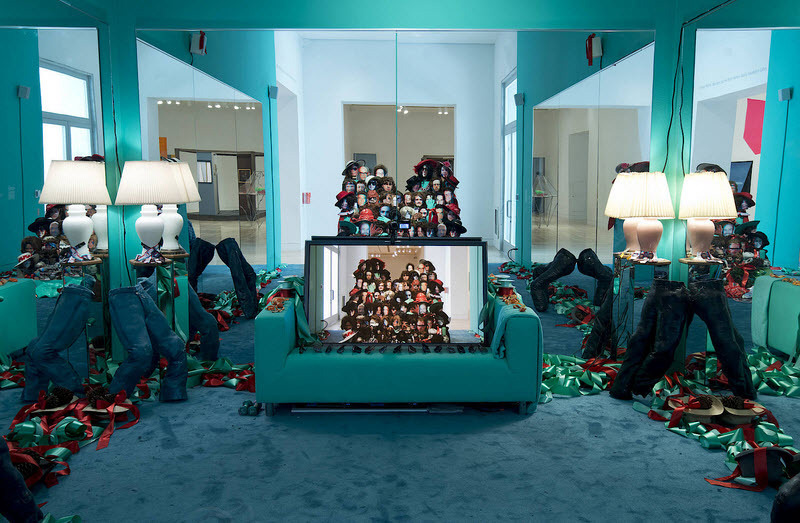
Samara Golden, Thank you. Made in L.A. 2014. Installation view at the Hammer Museum, Los Angeles. June 15-September 7, 2014. Photography by Brian Forrest. Courtesy Hammer Museum.
Through the mirror of my mind
Time after time, I see reflections of you and me
Reflections of the way life used to be
The Supremes, “Reflections,” 1967
Samara Golden is an interdimensional artist. She apprehends lost souls in humble masks, their faces burned into mirrored polystyrene (a favorite material). She builds plots that make the warp and weft of space-time seem less a cosmic phenomenon than an interior being, embodied in a single silvery room. Diving deeply into the other side of the looking glass, with all its concomitant absurdities and doublings, confusion, and bemusements, Golden finds in her mirror-world wanderings a powerful, melancholic kind of beauty. Brightly prismed, she bends past and possibility into that spectral spectrum, bringing into a single shattered crystal a confluence of memories, a whole life, an era, a world dreamed up to underlay the hard and angular suffering of this one. A life reflects back on itself, and strange things happen.
In 2013, Golden participated in an experimental exhibition at Cardi Black Box in Milan curated by Lauren Mackler and myself, titled “Set Pieces.” At the time of our interview, she had just concluded an exhibition at Night Gallery as well as a major installation at the Museum of Contemporary Art in Los Angeles. She was also working on Thank You (2014), a new installation for the “Made in L.A. 2014” biennial at the Hammer Museum. She will be having a solo exhibition this fall at PS1 in New York. We met at a café in Echo Park, Los Angeles.

Samara Golden, Mass Murder, 2014. Mixed media installation. Dimensions variable. Installation view of Blue Room, Night Gallery, Los Angeles. Courtesy Night Gallery.
ANDREW BERARDINI: Maybe we should begin with “Mass Murder,” your recent solo show at Night Gallery. In looking at that show, I felt like you’d taken this series of potent spaces, objects, and moments from your life and connected them all together in a single installation. It reminded me of this thought from Gaston Bachelard’s The Poetics of Space—that your psychological architecture is the house you grew up in.
SAMARA GOLDEN: I feel like that’s true. The main blue room of the installation was based on my living room when I was a kid. I grew up in a fake Frank Lloyd Wright house that had Plexiglas windows on three sides. It seemed really huge to me as a kid, but I guess it was maybe a 15-by-15-foot living room, which is still big but not as big as I remember. I wanted the main room (the blue room) in the installation to be a crazy-long existential thought—almost a nowhere place. The blue room had a piano, a fancy guitar, and faux-abalone boxes, all objects I remember from my grandparents’ house in Arizona. Behind the blue room, there was a red room that was filled with the light from heat lamps. This place was my other grandmother’s room when she lived with us in Michigan. It was where she smoked and drank and watched black-and-white TV. I really loved her. My grandfather divorced my real grandmother (the smoker and drinker intellectual) to marry the fancier grandmother who was “worldly,” who had “good taste.” I tried to put all my feelings about that situation—choosing one person over another, one lifestyle over another, etc.—into the show, and all the objects were based slightly on things belonging to my dad or mom or my grandparents.
AB: It was an emotionally heavy show, and there was something really moving and deeply personal about it. I loved the press release with that hard jewel of a poem: “It’s personal. It’s optimism and pessimism in a deadlock. It’s two stories. It’s bad blood. It’s a caged thought. It’s a purple light giving a performance.”
SG: I was really super sad for some reason. I started crying the night it closed. For me, the show is made in the process of making it—the accidents that happen while I’m making it, and what I’m going through at the time in my own personal life. All that stuff comes together to create something special that couldn’t be made at another time or another venue. I made the “Mass Murder” show specifically for Night Gallery; it was a real challenge for me to try to hold that whole space. It’s always madness trying to make all of the elements work together, and it’s even more madness trying to make it all truly be meaningful to myself. I felt a mass of emotion at the end of the show because I was never going to see that show again as long as I live. It was like that place was never going to exist again.
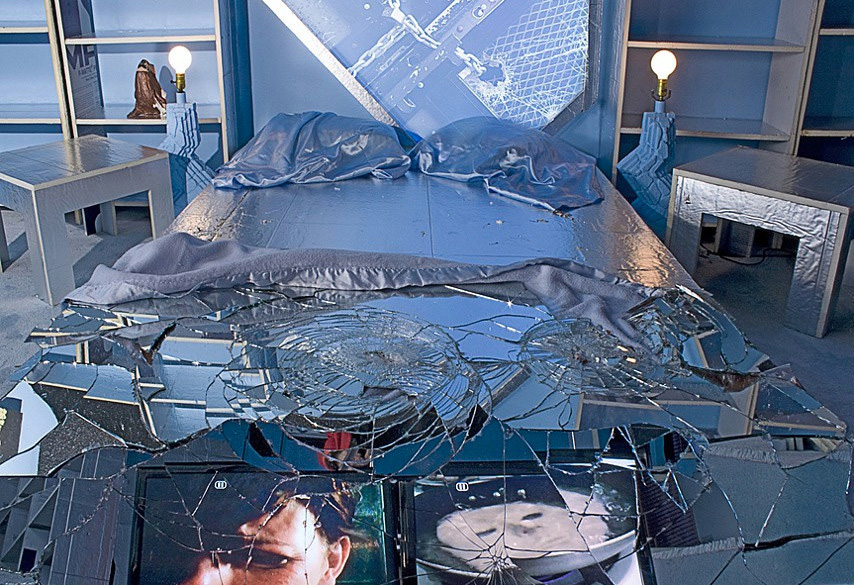
Samara Golden, Rape of the Mirror, 2012. Mixed media installation. Dimensions variable. Installation view, Night Gallery, Los Angeles. Courtesy Night Gallery.
AB: The new Night Gallery is capacious, so this didn’t feel quite as dense as your 2011 installation, Rape of the Mirror, at its original space—there was a lot going on physically in that one—but it still wholly captured the same intensity and the sense of heavy immersion in these freighted psychological interiors that I’ve come to love in your work. I was curious if you could talk more about working in the architecture of the gallery?
SG: I was really terrified about how big the new space was, and so I tried to let the work be more open. I thought of it as a big poem with little poems inside of it. Almost like a novel filled with songs. I like the idea that there is a big picture with a million smaller pictures and reflections inside of it. That way the levels of detail can unfold and unfold.
AB: Given the right conditions in visual art, a single small object can fill a warehouse.
SG: Sure. I see the minimal, graceful gesture in other people’s work, but I haven’t been able to trust the world enough to let it be just the one thing. There are so many conversations in the work going on at once, because that’s how I feel and how I wish to express it, but I worry that it’s a kind of a crutch as it becomes impossible to decipher.
AB: It can become more about the dreamy atmosphere than any specific object.
SG: What about the idea that you create this thing that’s a hectic-as-hell bubble of conversation, then all the parts can go out into the world and become their own graceful moves? I like that idea, but I haven’t quite figured out how to structure it. I put so much handwork into all the different objects, and I don’t want them to be stand-ins for things—I want them to actually be things.
AB: I can make leaps about certain objects, but what are the “guides and guardians” in the kitchen?
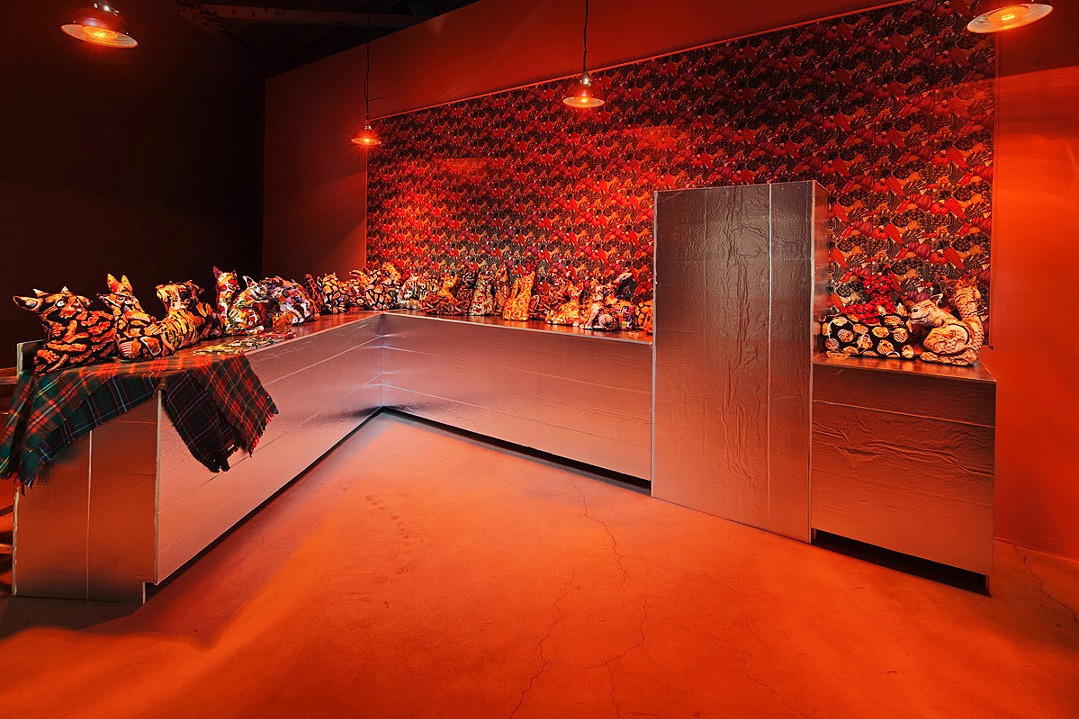
Samara Golden, Mass Murder, 2014. Mixed media installation. Dimensions variable. Installation view of Red Room, Night Gallery, Los Angeles. Courtesy Night Gallery.
SG: They were based off the other body of work about why the world always has to be about war and torturing animals. That’s a really simple way to put it, but it’s the real pain of torturing sweet, innocent creatures everywhere. I tried to make those stuffed animals, those creatures. The guides and guardians are animals. When I was 30, I was in the hospital and almost died—I had pneumonia. They put me on tons of morphine. I was on my deathbed, and I was hallucinating all of these electric animals around me, jumping from the top of the bed onto the floor. It seemed really normal in my own mind. I just accepted their presence; I didn’t question it. Since then, I’ve been trying to find a way to make those electric animals but have always failed: How do you make something that is not real in our reality become a real physical thing? The way I remember the animals, they were made of transparent electrical energy, multicolored spiky shapes, much the same way that a migraine aura looks. In the kitchen space, I wanted the animals to come in and out of the wallpaper, so I made fabrics that were covered with crazy patterns. It’s psychedelic, but I was thinking about it more as psychological. I’m interested in how the psychedelic is perhaps how we normally would be—i.e., how we might normally perceive the world if we didn’t filter our experience so much.
AB: Like the way that psychedelic drugs teach a person that the instruments of perception are pretty limited, that there’s this whole other layer of reality that we just normally aren’t able to access?
SG: Or another way of thinking about it is that you bludgeon yourself into being able to accept this very limited form of reality so that you can survive and be happy. I remember wondering many times in my life, why do we have to work a job in order to have shelter and food the way we have it? Objectively, it doesn’t really make sense.
AB: One way of demarcating reality is by marking time and its passage through a space, space-time in a person, through objects. Like your project at Workspace and perhaps the installation for “Made in L.A.”

Samara Golden, Thank you. Made in L.A. 2014. Installation detail at the Hammer Museum, Los Angeles. June 15-September 7, 2014.
SG: For the Hammer show, I’m making a sculptural installation that is the second iteration of a lifelong project that I started in 2010—it’s a sculpture that’s made up of everyone who ever looked at it. This way of thinking has a really different conceit than everything I’ve done since. The first iteration of the project was shown at Workspace. It was all these sculptures, dolls—even though I hated dolls—of all the people who I had discussed making the piece with. I called that iteration The Conversationalists. It was the first project I did when I moved to LA from New York, when I had almost no friends here at all. My original idea was that each iteration would be made of a different material—i.e., the show in Paris, in the proposed future, would be sculptures made of painted silk and the show in Berlin (in the proposed future) would be sculptures made of carved wood. I’m diverting from that idea a little; the installation at the Hammer will use many different materials all together: 3D anaglyphic photos glued on cosmetology heads, ceramics, pantyhose sculpture, etc. I started experimenting with making anaglyphic photo and video for The Fire Place installation that was at MOCA last fall. I like the way you can create an altered reality with very simple means. As I said, the project was supposed to go on through my whole life and be a survey of all the people that have been near me, but I guess it’s really more of a personal piece than it is a survey. You will be in it, Andrew.
AB: How did you decide this was the right idea for the Hammer? Maybe you could go into some more detail about the process.
SG: Connie Butler and Michael Ned Holte [co-curators] requested that I do the second iteration of the project for the “Made in L.A.” show. In a way, I think it’s fitting because the piece is really about community. So much of my work has been based on my inner world that it was sort of a relief that they were interested in my doing this project.
To describe the installation a little bit more, there are probably around 75 people represented in the sculpture. Everyone is either someone whom I’ve talked to in great detail about making art or someone who had seen the first sculpture—in essence, it’s all the people that surround the small art scene that we are a part of here in LA. It’s my friends, peers, gallery people, curators, etc. About 55 of the busts are cosmetology heads with inkjet prints of their faces sort of stuck on. There are also ceramic hats and wigs, real hats and wigs, some of the original dolls I made for the first iteration, pine cones, sculptures made from pantyhose, hands, and printed jewelry among other things. The whole room will be painted green-blue and coated with mirrors. Over all, I think the installation will have a sort of Christmas-meets-poolside aesthetic.
All the heads are arranged on a stepped platform, and they all face a camera and a monitor that are on a couch. The viewer can look over from behind the platform to see her own face in with the crowd of sculptures in the monitor. If the viewer chooses to come around the front of the sculpture, she can try on a pair of red-blue 3D glasses that I made—they make the faces look ghostly, like they are moving around. It’s supposed to be surreal, impossible-looking, like they are not quite there.
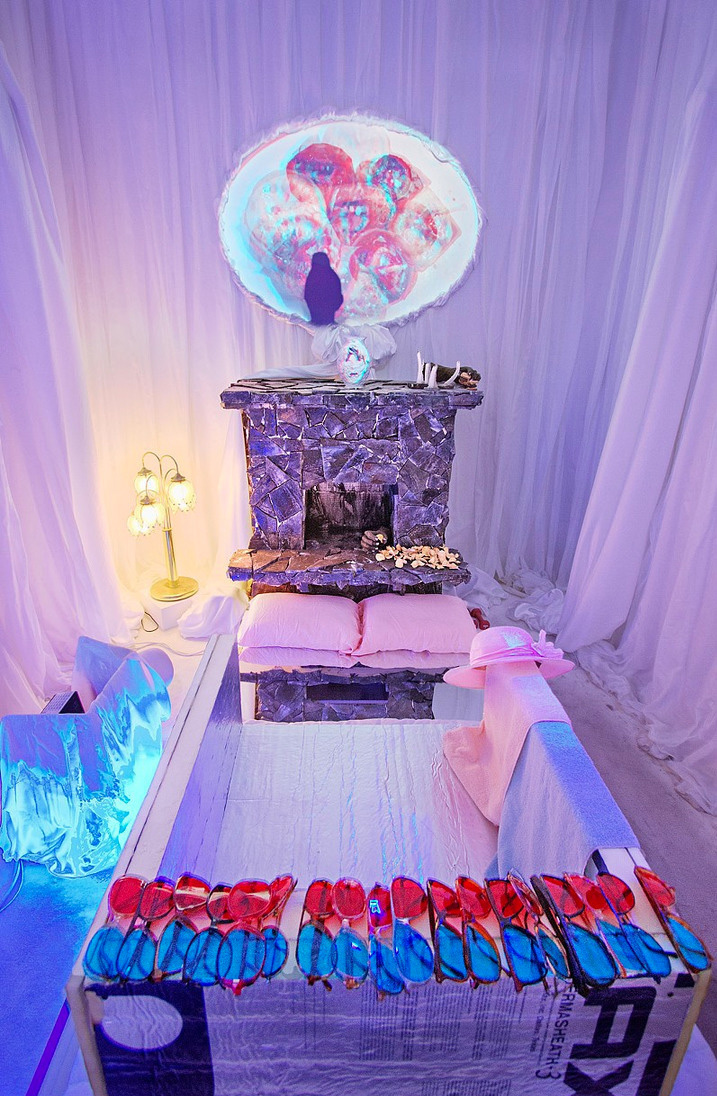
Samara Golden, The Fireplace, 2013. Mixed media installation. Dimensions variable. Installation view, Museum of Contemporary Art, Los Angeles. Courtesy Museum of Contemporary Art, Los Angeles.
I started making things 3D in The Fire Place piece at MOCA and have enjoyed its ability to make things look unreal. Making things anaglyphic 3D is fairly easy using Photoshop or Final Cut. I’m not much of a technology person, but it’s fun to try to use it if I have a specific idea in mind that can’t be achieved another way.
It’s a little hard to explain what it all will look like, but I see it pretty clearly in my mind. There will also be two soundtracks playing at the same time and a lot of other little details.
AB: I’m glad you mentioned your recent installation at MOCA, The Fire Place [2013]. It feels to me like a sequel to your work for “Set Pieces” in Milan.
SG: It was. It was the culmination of that work. I started to develop some of the ideas in the show in Milan, and then I got to make another, more complicated version of it at the Marlborough Gallery in Chelsea. Then I got to realize it in a more finished form and reshoot all the video in 3D for the “Room to Live” show at MOCA. I thought it was really nice in a way to test out an idea and experiment with it and watch it grow into something else. The show at MOCA was up at the same time that “Mass Murder” was at Night Gallery. I think that they were good counterparts to each other; one was a brain, and the other was a thought. I was also happy to have a counterbalance to the crazy way of thinking that was in The Fire Place piece.
AB: How is one a brain and one a thought, and which is which? What is the crazy way of thinking in the MOCA piece?
SG: I guess I was thinking that the installation at MOCA was a brain; it was a brain having a cyclical thought, one repeating cyclical thought. And I was thinking that the “Mass Murder” show was one big thought (the blue room) in contrast or conflict to another big thought (the red room). I know it seems weird or abstract or like nonsense, but for me that is how I think about it now—undoubtedly I’ll think about all of this differently in five years, since my perception is always changing and rewriting the past.
AB: In Kurt Vonnegut’s Slaughterhouse Five, these beings called the Tralfamadorians live in the fourth dimension and can see space-time: past, present, and future, all moments simultaneously. We’ve talked about the sixth dimension before, and I was curious if you’d talk a little bit more about it now?
SG: I have this whole credo of the sixth dimension, which was built into the Rape of the Mirror as well as into the project I did for Frieze called Bad Brains [2012]. The idea for me is that time is not a line, but instead it’s a million possible futures, pasts, and presents, and they can all coexist in one location. Like, this room we are in can be a snowy mountaintop or a swimming pool on top of a skyscraper or a cabin in the 1800s—it’s one place that can hold many locations and, more importantly, many feelings.
AB: We only perceive time as linear. Even within us, our childhoods and the potentials of our future exist together. Memory is not nostalgia; memory is alive.
SG: I like the idea that the object can hold all that stuff. I guess it holds the things that you’re thinking while you were making it. It builds up something inside of the object that makes it special and real—hence the object is a culmination of all the thoughts and feelings that went into making it. Of course, anyone else who comes into contact with it will have their own associations. I guess my hope is that if enough goes into it, then something will come out, that the thing will have a feeling or even a personality, or if you’re really lucky it will have multiple personalities.
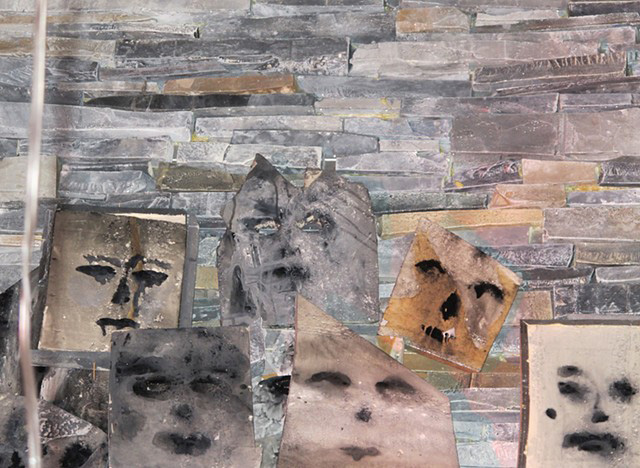
Samara Golden, Bad Brains, 2012. Rmax foam insulation, paint, glue. Detail of handmade faux rock wall and “Suicide Masks,” Frieze Art Fair, New York. Courtesy Night Gallery.
AB: How do we invest power into objects that would not otherwise have power—like your Suicide Masks [2012]? I ask because you said earlier that the things that you were making were not stand-ins for things but the things themselves.
SG: I was just thinking about those masks. I started off with the idea of making masks of people who I had known, but then it ended up that they became their own people. The more I lived with them, the more they became like these creatures. They became faint shadows, and each became a spirit—somebody. I thought of it as giving a feeling a face. I didn’t really know what I was doing at the time, but for me that ended up being a lucky moment for me, when you are able to manifest something that feels right, and in essence turns into its own thing. I guess that is sort of like the old adage about how Michelangelo just freed the sculpture from the rock. I was also very happy that I made those masks out of a fragile material, RMax foam. To me, it meant something that they were fragile and can easily be broken—just like the people they represented.
Every time the masks ship, they get broken and I have to tell the people how to put more glue on them and fix them. I like that, but I know it’s a hectic, capitalist problem for everybody. I feel kind of torn about how much I should fight for the fragility of everything. I don’t want to make other people work to fix things for me all the time, but I do think it’s interesting if someone has to care for the thing. Then maybe they develop a different kind of love for it? Jon Kessler once told me that you have to make stuff out of what you like making stuff out of; you have to actually enjoy the process of working with the material and actually want to work with it.
AB: How would you define for yourself the difference between concept and material?
SG: I always think of making art as something that I see inside myself. I want to see it become real. But it’s also all the small things that happen along the way. I don’t think it’s very powerful if you set out to make something and then it looks like what you wanted to make in the beginning. I hesitate for a moment there, as I don’t want it all to be about selfishness. I know the world needs its cultural workers so it can advance. But I hate to think about myself as this totally self-centered, selfish person.
AB: In writing school, they teach that if there’s no inspiration for the writer, then there’s none for the reader. The emotions we manifest in ourselves through art are our gifts to others; there’s a generosity to others in being vulnerable in your own work.
SG: When I talk to Leigh Ledare, he calls that high stakes. When the work is going to go to a place where you don’t know how it’s going to be received at all, only that it’s revealing of yourself and your thoughts. It’s scary.
AB: The way that I achieved freedom when I was younger was by being reckless; being reckless allowed me to be brave. I think we all have this experience of being possessed of an impetuous energy that allows us to go out and get drunk and dance late—perhaps be brash but definitely be free. Those moments can be really self-destructive. Now I think, how can I create that freedom without the kamikaze self-destruction?
SG: For me, I associate one with the other. Why does the world have such a small parameter of what’s expected, what we need to be happy? Humans have really strong emotions. I miss just being able to have a good time, a crazy-good time. My most favorite times were when I was with a friend and we just wandered around with no plan. It’s where I get a lot of inspiration—but it’s not a practical way to live in the capitalist society that we are all a part of. I have such respect for people who do things their own way, people who reject the way things are done. It’s a very hard existence with all kinds of troubles; no one even treats you like a person if you don’t have a house and money. I always liked the idea that in certain countries philosophical gypsies, monks, wanderers, and thinkers are respected parts of the social fabric, that they are considered a necessary part of life. It’s sad that there isn’t a place in this world for wanderers.